There is currently a new general interest in court masques. They emerge from three principal types of festival:
- The State Entry (to welcome a prince or king)
- An Exercise of Arms (e.g. a jousting match)
- Other sorts of spectacle (inside or out, singing, dancing, music, including the court masque)
1. The State Entry
When James I entered London he went through seven arches. Fenchurch Street Arch (has a model of London on top) was a State Entry. The arches were made of wood and canvas and paper mache and were painted bright colours. They were very large and some had balconies with people on. Nothing remains of them anywhere in Europe. We have descriptions from people who were there, sometimes official. All seven of the James entry arches were designed by Stephen Harrison. When James entered London the trade guilds each erected arches, some mythological, some historical, some allegorical. It was covered in a silk curtain painted to look like a cloud that was wiped away. Each arch had a speech written by Thomas Decker and Ben Johnson.
Did everyone understand the speeches? Unlike Shakespeare there is no knockabout humour so very few would understand the allusions but people were conditioned to understand a lot of the themes (perhaps like complex traffic laws today that in a hundred years they will wonder how everyone knew them).
It was paid for by the City of London to show their wealth and status. James I hated the whole thing unlike Elizabeth who was a PR genius. She replied off-the-cuff to each speech and addressed the people. James sulked in the back of his coach and as James coach passed the crowds “expressed their silent joy”. James and Charles did not like meeting the people so they retreated to the interior of the court. For example, in jousting or the Garter ceremony in Elizabethan times anyone could come and enter or view the proceedings but James made all the ceremonies private.
James also did not like them as the speeches could be used to make a political point, e.g about true religion, smashing idols, bringing in stronger Puritan laws and so on. By the early 17thC it was the age of absolute monarchs and they sis not like being criticized or pressurized an any way.
2. Exercise of Arms
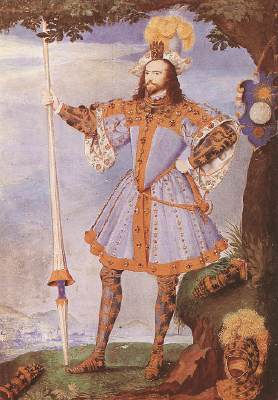
Nicholas Hilliard, Earl of Cumberland, 1590, shows a tilt. It started in Elizabeth’s reign. James came to the throne on the 24 March and every anniversary there was a jousting match but by the end of his reign it had died out. Cumberland’s leggings are armour. He could also come in fancy dress – as a shepherd knight or an ice knight for example. Cumberland is not wearing fancy dress, the suns are allegorical and the shield has a complex meaning he would explain. In Elizabeth’s reign she liked short amusing speeches that were light hearted and would stop anyone whose speech she did not like. In James reign each knight brought a shield on paste board and the meaning was explained at length to the monarch. In this case his motto is Haster Qun – defend the king with his lance till the end of time, represented by when the sun, moon and earth are aligned (i.e. never – he thought). Shakespeare devised one of these shields. The idea of jousting was to break your own lance showing you had hit your opponent and the winner was the person with the most broken lances. They did not try to knock the other person off their horse as this could kill them. Henry II of France died from a jousting accident, a long splinter of wood from a lance having pierced his eye and brain.
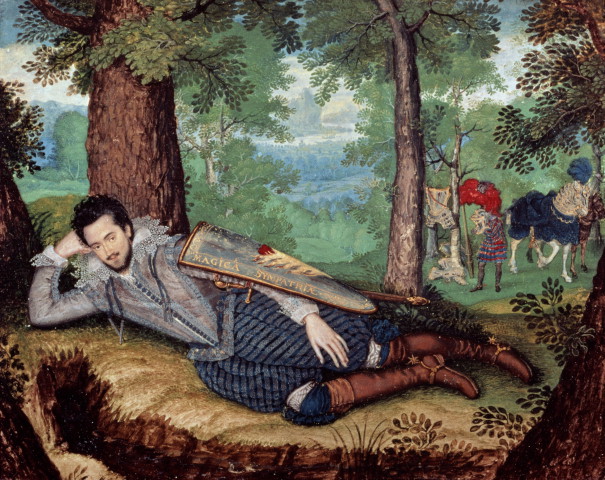
Lord Herbert of Cherbury, Isaac Oliver, 1610s. This is the same person that a lady was found looking at his picture at night by candlelight. His impressa says “Magica Sympathia” (sympathetic magic) showing his interest in alchemy. The pose shows he is a melancholic (see Durer’s Melancholia).
Inigo Jones, 1610, design for an elephant at Chatsworth House. Accession Day tilt 1610 for Lord Dingwall, instructor on arms to Henry, Prince of Wales. The elephant was described as very slow and it got in the way of the jousting. It is not known if it was powered by men inside or by a horse. The impressa in Italian says “He who cannot do this is a mere shopkeeper.” (we don’t know exactly why).
None of this is peculiar to England. 15thC and 16thC Italian Renaissance courts had jousting, medieval romances, King Arthur and so on.
Touroir a theme – a themed joust that followed an allegorical plot. Each person had a role they had to follow and it had songs and scenery. It also started to move indoors – Barriers. The tilting yard in Whitehall is where Horseguards’ Parade is now. They literally fought across a low barrier or fence standing each side.
In 1610 Henry had Prince Henry’s Barriers at the earlier Banqueting House built for Kames I in 1606 (burned down in 1619) on the 12th night (6th January) to inaugurate his coming of age.
At the Christmas before he had sent his knights to issue a challenge with a drum and trumpet. Meliadus (Lord of the Isles) was the guise for Henry (an anagram of soldier of God).
See text of the speech of Henry’s Barriers. The Lady of the Lake is revealed and has the first speech. James would sit at one end looking down the barrier to the stage with the court either side. Merlin then introduces Meliadus and his knights (line 130),the door at the centre opens to reveal them. Merlin summarises British history and the monarchs. See line 194 “88” means 1588 the year of the Armada – a reference James would not have liked as he signed a peace treaty with Spain. It is turgid, boring nad all political propaganda. It is constructing an ideology, the party line, through allegory, Platonic concepts, team building, shared values and ideas.
St. George’s portico (see handout). Trajan’s column on the right, a Roman triumphal arch on the left. Classical architecture and medieval Gothic in the centre. Bottom left is Merlin’s tomb with scrollwork, based on the Medici tombs by Michelangelo.
It has an antique classical air. It was believed at the time that ancient Britain had its own classical tradition. Inigo Jones studied Stonehenge and concluded it was an example of British classicism. A peculiar hybrid. The Ancient of Days when Britain was united is created again by James. It was believed Brutus I of Troy came from Troy to create ancient Britain in classical form (see http://en.wikipedia.org/wiki/Brutus_of_Troy ).
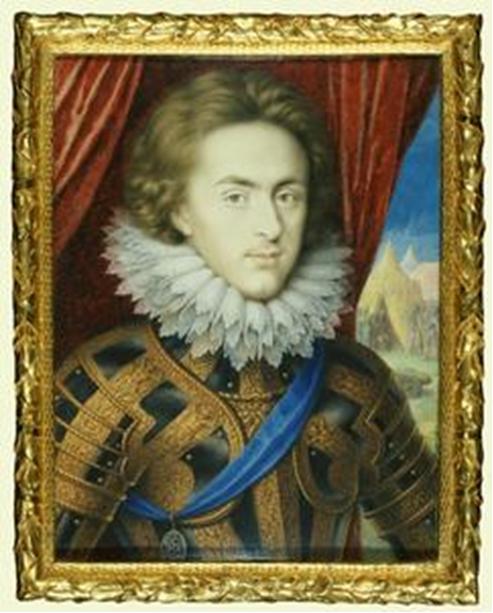
Isaac Oliver Henry, Prince of Wales. Has a tent in the background, a medievalizing image and a fascination with chivalry.
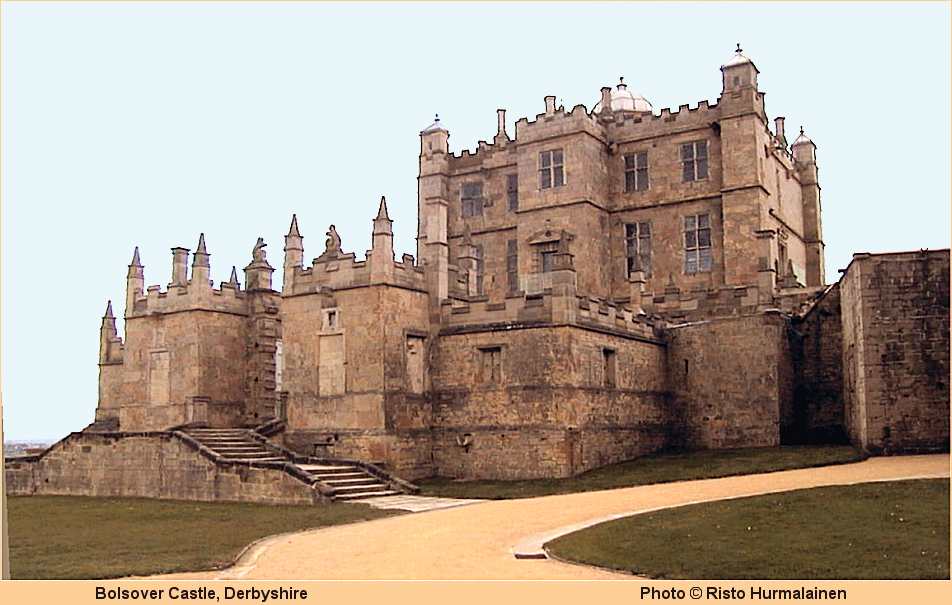
Bolsover Castle, 1612 onwards (the riding school also still survives)/ This is “The Little Castle” and has recently been opened restored by English Heritage. It is a medieval revival because of the crenulations, arrow slit. There were Gothic revivals in Elizabeth’s reign, James reign, John Smithson designed it (son of the better known Robert Smithson). The interior details are also Gothic.
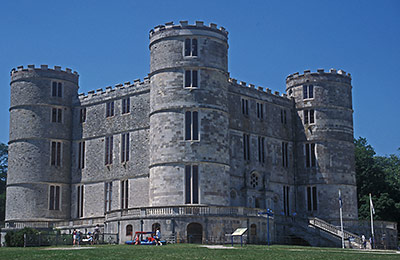
Lulworth Castle, 1607. Gutted by fire in 1929 and recently restored. Early Jacobean mock Gothic lodge, but Tudor portico, classical columns, windows too large (easy to beseige – you just climb in the windows), regular fenestration.
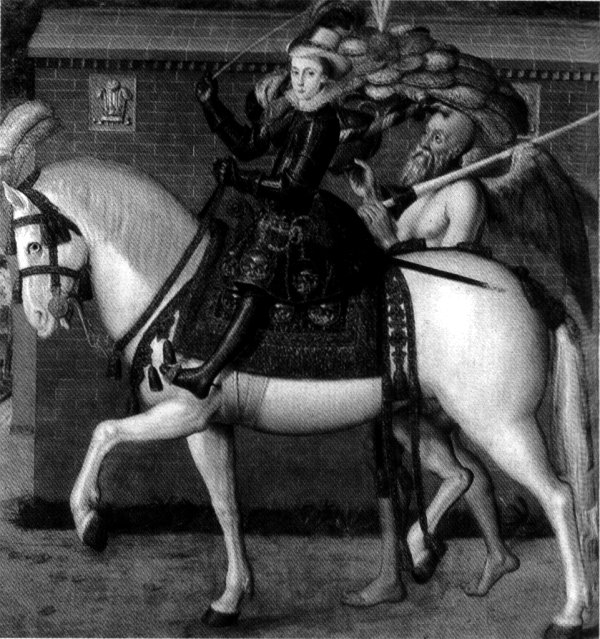
Equestrian Portrait, Robert Peake.
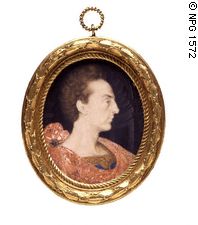
Isaac Oliver, Henry Portrait miniature, 1612, Royal Collection. Henry dressed as a Roman Emperor in a scallop shell niche. Profile like a Roman Caesar, He is different in each portrait but in 1610-12 he was growing up very quickly and so changing rapidly. He is wearing a toga with a ram’s head clasp. In the Barrier it says “To Henry V whom you are so like”.
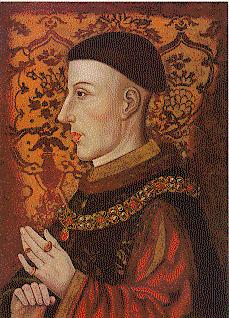
Portrait of Henry V, 1420 from a popular series in 16thC England. Henry V is the only king shown in profile – an additional layer of association.
The king could be lobbied in the text of a masque. In Henry’s Barriers there is a strong call to arms. Reference to the Armada but James signed a peace treaty. So it is not simply royalist propaganda, an interplay of ideas. The writer was Ben Johnson who was the king’s poet so he was in a difficult position representing Henry’s belligerent views for James’s peaceful tastes. So a masque was full of intrigues and politicking it was not just frivolous fun.
